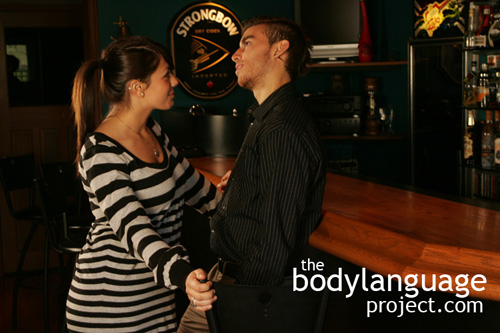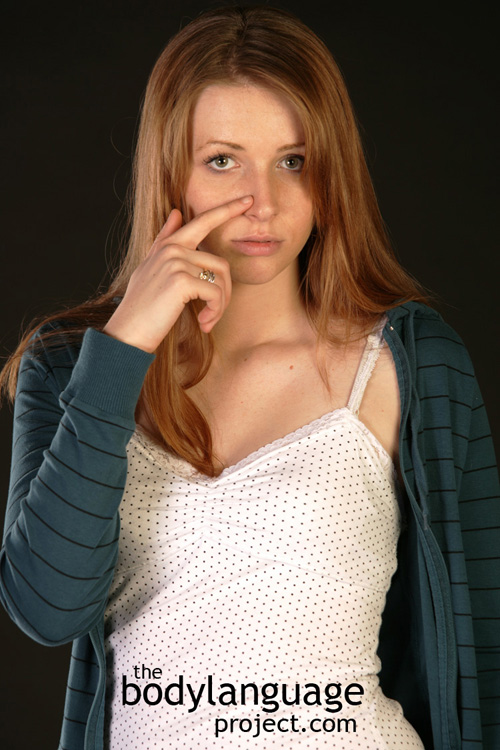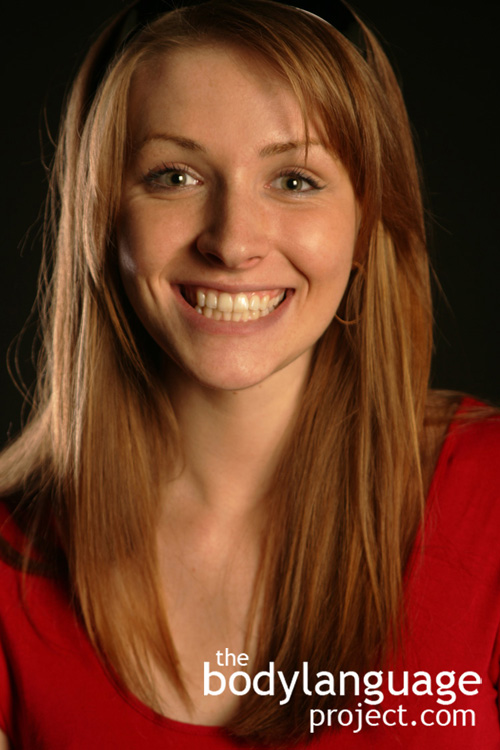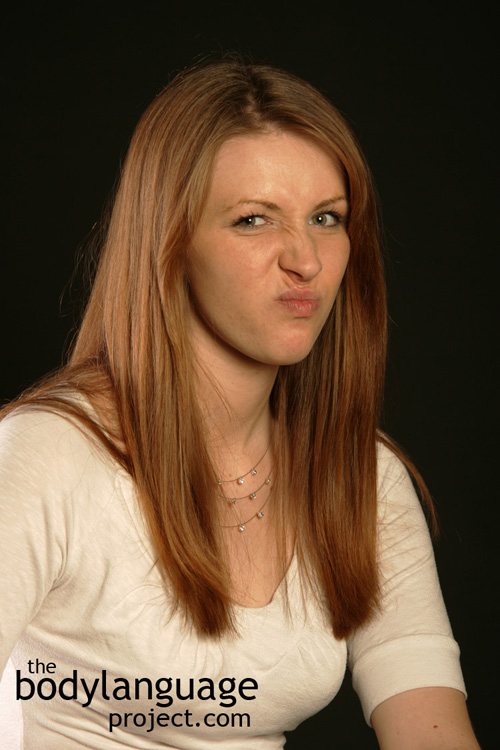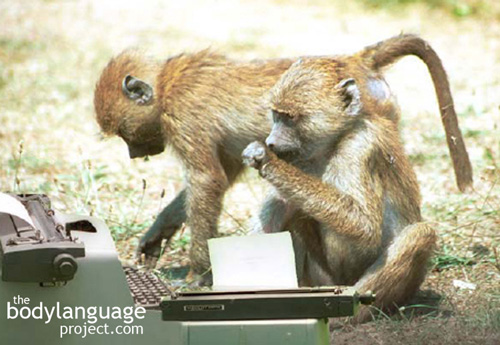Body language is a fundamental part of courtship. As we have learned, verbal language is risky and not only because it may lead to embarrassment, but because it often requires a verbal response from others, which can turn out to be tragically embarrassing. Keeping spoken words out of courtship initiation process and therefore out of consciousness will save us plenty of grief from being openly rejected, or perhaps even worse, negative feelings with having to reject. Using and reading nonverbal cues therefore is important in courtship, so pay particular attention to the following signals so you can judge interest yourself, without saying a word. Courtship signals are extensive and complex, perhaps numbering in the thousands, so I will only cover the basics here. For those that want more detail, they may wish to read my e-book Body Language Project: Dating, Attraction and Sexual Body Language (2007). Much more emphasis is placed on instruction for men to help them read women better, although it can be helpful to women who wish to send more appropriate signals of attraction, rejection or to simply bring from the subconscious the signals they use all the time.
Tag Archive for Caption
Turtling – It’s When The Head Goes Into It’s Shell
by Chris Site Author • March 6, 2013 • 0 Comments

Turtling is a limbic response to confrontation. The head sinks, shoulders shrug, and the body takes on a smaller form to avoid being seen as a threat.
The posture happens as the head seems to sink inside the shoulders, however, what is really happening is that the shoulders are slowly being raised so the neck disappears taking the head with it. It is as if the head is being swallowed by the shoulders. We see this posture when people are uncomfortable, have low confidence about themselves or a topic, have insecurities, feel weak or powerless, ashamed, or are carrying any other negative emotion. It is usually found when someone is centered out on their poor performance. The origins of the head turtle is to protect it from harm. For example, when people hear a very loud bang, they will quickly pull their heads inward and down, and tuck their chins. However, when it is done out of shame, it happens more slowly and deliberately so as to draw even less attention.
It usually happens when people want to appear less significant so they are ignored rather than called on. In business the head duck will occur when subordinates meet with superiors as they try to stand out less and look less significant or when employees wish to be overlooked during status reports at a boardroom meeting. It might also happen in class when the professor is calling on students who don’t have the answers, or when athletes have to walk back in shame to their dressing rooms after losing an important match.
Introduction – Chapter 10
by Chris Site Author • March 6, 2013 • 0 Comments
It’s not a stretch to say that reading attentive and evaluative body language is a useful skill for everyone at one time or another. For teachers, attentive and evaluative body language cues are useful to read student interest and their level of active thought, for sellers it provides a gauge to the efficacy of a pitch, and to acquaintances at a social even, the level of engagement.
A presenter at a conference might want to measure his story telling skills and so might look for cues to “undivided attention”. He might therefore be interested in shortening presentation points that create fidgeting and shuffling. The salesman, on the other hand, also wants to avoid boredom, but needs to watch for evaluative gestures such as chin stroking, flared nostrils, pinching the bridge of the nose and rubbing the back of the neck to see how close he is to closing the sale and what level of decision making is at hand in his target. Does a chin stroking mean he’s already made up his mind and is mulling things over, or is he just satisfying and itch?
Naturally, as the stakes rise, so too does the importance in reading evaluative and attentive body language accurately, so it is important to keep these cues at hand. In this chapter, “attentive” refers to the level of interest expressed during an interaction whereas “evaluative” delineates indicators that a decision is in the process of being made. This chapter, while brief, covers a significant subset of the body language that happens as people are in thought, give undivided attention or lack thereof and show that they are preparing to reach a decision. We also hit on the hidden meaning of glasses, hand steepling, neck rubbing and a subset of additional evaluative gestures we might encounter in our daily lives.
Introduction – Chapter 9
by Chris Site Author • March 6, 2013 • 0 Comments
In this chapter we will cover defensive and aggressive body language. By examining them together we can link them in our minds, yet keep them distinctive since they are near opposites. We use defensive body language to figuratively protect ourselves against aggression, which isn’t always physical either. In fact, the vast majority of the body language we will see, and appropriately label defensive, is that which stems from emotional roots. After all, our evolution selected defensive body language came about under primarily physical circumstances. Being yelled at, or scolded by a superior or rival, is similar in a visceral sense to physical abuse. Any emotionally abused victim will tell you that the suffering they experienced, is equally, if not more sever than that experienced by those physically abused. In most cases threats in our daily lives come in much milder forms, such as high pressure sales, a heated discussion, or a disagreement.
Defensive body language is a set of postures that make the body feel protected, secure and comfortable in awkward situations. Defensive body language is also similar to submissive body language in that the postures are aimed at protecting vulnerable parts of our bodies, or in size reduction turning our bodies into smaller targets.
Aggressive body language is nearly the mirror opposite. Here the body prepares for a real or figurative attack as it becomes loose or tenses up and tries to appear larger and more threatening. Aggressive body language can happen by clenching the fists, finger pointing or flared nostrils more technically termed “nasal wing dilation”, and much more as we will see. Aggressive body language is simple to read and classify because we instinctively find them to be a salient part of our lives. In fact, it is hard to go through life without properly identifying aggressive body language. By missing cues to aggression, even just once, it leads to disastrous conclusions which we naturally learn in short order how to avoid. Defensive body language, on the other hand, because it is less of a threat, can easily be mistaken for regular actions in a persons repertoire and be ignored. This is why we cover defensive body language in much greater detail.
This chapter will cover defensive body language such as the double arm hug, partial arm cross, arm gripping, fist clenching, the use of “security blankets” for comfort, using stiff arms, how barriers are used to reduce angles of attack, how barriers like books and headphones can be used to our advantage, in addition to others. We will then cover aggressive body language and signals of aggression such as the unblinking eyes and personal space invaders.
The Ankle Or Scissor Cross
by Chris Site Author • March 5, 2013 • 0 Comments
The ankle or scissor cross is where the ankles cross each other and is a posture that can happen while seated or standing. While seated this posture is a hidden form of leg crossing because it occurs discretely at the bottom of the legs and can be out of sight due to a desk or table. While standing, it is the only way legs can cross so has a similar meant to a regular full blown seated leg cross. At times the leg might be raised up the backside of the calve producing the appearance of a flamingo but this posture is mainly reserved for women. While seated, the legs can also be locked behind the legs of a chair with essentially the same message being delivered except in this case it is a restraining-freeze-behaviour. When the legs are wrapped around the chair they can’t move, hence they are locked, and are also there precisely so they don’t move, and are hence frozen. Women are also seen using the sitting position more often them men especially if they are wearing skirts, however, it is not a confident posture so should be avoided. When it does happen in men though, it should be noted since it is an unnatural position in general for them.
The ankle cross indicates that the person is holding a negative emotion, uncertainty, fear, feels discomfort or threatened, stress, anxiousness, insecurity or timidity. The ankle or scissor cross also shows reservation and self-restraint,
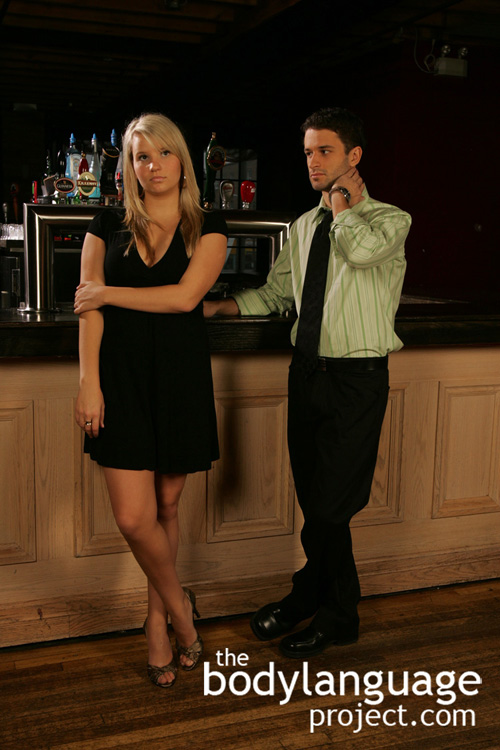
Lots of cues in concert. Arms in a partial-cross coupled with crossed ankles – and he’s not doing much better as he ‘holds himself back!’
due to withholding of a thought or emotion. When being pitched, it shows resistance to the sale and when being questioned might indicate that lying is taking place. Couple interlocked legs, which is a freeze response meant to reduce foot movement, with pacifying behaviours such as rubbing the thighs palm down, as if to dry them, and you’ve got a cluster signaling that a secret is being covered. If the feet are pulled under the chair, the message is even more exaggerated. The feet are saying exactly what the person is thinking, that he or she is closed and withdrawn from the conversation. We should be watchful of this posture when presenting a controversial opinion to see what degree of disagreement is present and especially if the posture is held for a significant length of time, particularly by men. When the ankles cross it is due to a subconscious freeze response due to a threat and the legs are entwined so as to restrict and restraint movement.
As we saw previously, closing a sale or changing opinions necessitates open minds and since our bodies and minds are linked should try to open those with the scissor posture when possible. You could try to have them change positions, as above, by having them stand or relocate to a more comfortable seating location, or you could take the time to identify and address whatever issue is of concern. This is important especially if the posture preludes a more intense selling session to follow, since negative postures early on are a good predictor of the future.

Mixed message – head cocked to the side shows interest coupled with arm and ankle crossing – she’s uncertain.
In a free-flowing interview or discussion noting the timing of ankle cross’ can prove valuable. With some research or prodding it might be possible to reveal the true reason for the action. Simply asking the reason for the reservation can help eliminate this posture as well because it will make the person feel listened. This is risky, though, because the primary reason for the gesture is to conceal an emotion. Conversely, giving someone the opportunity to express their thoughts makes people feel heard and sometimes that is all that is needed to open someone up. The posture after all, is a posture of hidden disagreement, so it would be hard to hold the posture as one is given the chance to open up. If the posture returns after some time, it might indicate that the person hasn’t fully disclosed their true opinion on the matter or that a new issue of contention has been uncovered. Therefore, once again, time should be taken to address any concerns that might have arisen before moving forward.
Introduction – Chapter 7
by Chris Site Author • March 5, 2013 • 0 Comments
Openness can sometimes be confused with simply being relaxed or intense, and to some degree this is true. For example, being open often means that attire is also relaxed, shirt collars are unbuttoned, ties removed, the pants might hang loose and certain articles like jackets might be removed. Full openness, therefore, is not always acceptable. Conversely, we might look at being open as simply a lack of holding closed cues. That is, having open cues is the exact same as not displaying closed cues and is the default position of the two. Being closed requires a certain amount of tensing of muscles and therefore effort so the default of most people is having an open mind. In other words, people are open, unless they say otherwise! It follows that there are far fewer cues to symbolize openness as opposed to closed, since being open is more of a passive state.

Closed body language happens whenever a part of our body crosses the center-line. Arms are shields that protect our torso from harm.
When closed postures are combined with other closed postures, the signal intended is made more obvious. For example, leg crossing in combination with arm crossing is much more potent than either alone. Add to this an expressionless face, turning away, and one is left to assume that communication is not welcomed at any level. On the other hand, we might be faced with someone who has their legs crossed but the arms are opened and honest. In this case, we might assume that it is a deliberate and conscious attempt to appear relaxed, when in fact the person might not be relaxed at all. It might be the case too, that someone has mixed feelings and is reserved at one level, but open at another level. Reading opened and closed body language is tricky business, but all cues are additive. Cues of the same origin, happening together, serve to strengthen an open or closed reading, but so too does conflicting cues. Conflicting cues tell us that someone has an internal reservation, made obvious through their mixed message.
It is fortunate for those of us who wish to modify our body language, that we have control of our conscious mind, since we then can modify our body language as desired.
Of course, since de-linking of our bodies and minds is difficult, these changes bring about inherent change in our attitudes as well. For example, it’s fairly easy to consciously carry open postures, such as palms up, arms and legs uncrossed, and hold active eye contact, however holding these postures necessarily leeches back into us creating open feelings.
In this chapter we will examine the vast array of open and closed body positions that we can use to come across as more or less open, as we desire. Naturally too, we will be able to identify this same body language in other people and use it to our advantage when reading them.
Introduction – Chapter 5
by Chris Site Author • March 5, 2013 • 0 Comments
The language of the eye has been shown by researchers to be more reliable than other body language because the movements the eyes make are involuntary and fleeting. This makes it hard for people to pay as much attention to them as, say the arms, hands or the legs. Eyes straight ahead while considering an answer, as we will see means that a prospect is passively considering information, the eyes down means that someone is concentrating or evaluating and the eyes upward means that an idea is being analyzed. Conversely, eyes looking off into space indicates a loss of interest, and eye contact avoidance indicates submission or fear. We can also tell a lot about what a person is thinking just by how the eyes move and then relating it back to context as we shall cover later.
In the seventies, Michael Argyle found that about sixty percent of conversation involved some form of gazing. He found that only thirty percent involved mutual gazing where the eyes met and held eye contact directly and that people look twice as often (seventy-five percent) while listening, versus just forty percent while speaking. The average gaze length was recorded to be about three seconds long whereas mutual gaze lasted just over one second before being broken. Eye contact has been found to be related to both cultural and personality differences. For example, Japanese and South Americans use far less eye contact as it is thought to be aggressive and disrespectful and introverted people make less eye contact then someone who is extroverted. It has also been shown through research that eye gaze is an indication of patterns in speech. People will tend to look away as they begin to speak, presumably to avoid distraction, and will then return their gaze as they near completion of their thought.
Eye contact is also a great way to measure like-mindedness. The more agreement is formed between individuals, the more eye contact is present. Even under research conditions where strangers were forced to hold eye contact for extended periods of time, they reported a greater sense of liking. We also tend to distrust others who make poor eye contact with us because subconsciously we think they are trying to hide something. The following chapter deals with the complete language of the eyes including its hidden meaning.
Culturally Our Bodies Are All Basically The Same!
by Chris Site Author • March 5, 2013 • 0 Comments
Most researchers agree that the following six emotions are recognized by all cultures: happiness or enjoyment, distress or sadness, anger, disgust, surprise and fear. However, positions the body takes on to demonstrate these emotions vary across cultures. Since every person on the planet regardless of race or creed has the same underlying emotions and our body language is tied to our feelings, it follows that every person’s nonverbal language has similar roots, but like verbal language we don’t express ourselves exactly the same. Paul Ekman from the University of California has done extensive research into facial emotion recognition and has found just that, everyone across the planet is almost the same.
Happiness, sadness, and disgust had the best agreement between cultures, whereas fear and surprise tended to be confused, especially by the Japanese. Another rural population, the Dani people of West Iran, who are generally isolated from the rest of the world, showed a similar confusion between fear and surprise. Surprise is read as a straight upward lift of the forehead whereas fear engages the muscles between the brows folding them. The French call the area between the brows, the “grief muscle” and is active to express both pain, as well as when you wish to inflict it. The fearful face carries a momentary raise in the upper eyelids and a grimace comes across the mouth. Anger appears with a lowering of the eyebrows, flaring of the eyes and a tightening of the mouth or jaw. Fear, grief and surprise in addition to other facial expressions can quickly flash across the face in the form of micro expressions. Being aware of them can rouse opponents and in poker indicate ‘tells.’ As people check their hidden cards, be sure to watch for split second reactions.
Members of the Fore linguistic-cultural group of the South East Highlands of New Guinea whom had never seen movies, who did not speak English and had never worked with a Caucasians before were also able to read facial expressions accurately. Studies show that even blind children score similarly to sighted children in terms of facial expressions. Further research by Paul Ekman showed that a contempt expression was also none culturally specific and was recognized by Estonians, Germans, Greeks, Hongkongese, Italians, Japanese, Scotts, Turks, Americans and West Sumatrans. Ekman traveled to a remote population in the mountains of Papua New Guinea where there is no television, DVDs or movies yet found that facial expressions remain universally understood. Once there he filmed the expressions of the population and found that upon his return were also understood by Westerners.
With very little exception, facial expressions are universally recognized. What does differ from culture to culture is our surroundings; our habitat and traditions. Greater differences therefore lie in our territoriality, level of eye contact, and touching norms. These factors tie back into the density in which we reside, and also into our comfort tolerances and preferences due to our upbringing. Gestures are mostly learned and passed from one person to another and are thus not universal across cultures. Gestures are more similar to verbal language. Because language and gestures are transferred over time they also evolve.
Introduction – Chapter 1
by Chris Site Author • March 5, 2013 • 1 Comment
Body language is an exciting tool and I often refer to it as such because I can use it like a wrench or screwdriver and sometimes even a hammer whenever I need it, but sometimes even just for fun. Most everyone has had some sort of fascination with body language and has thought consciously about it at one point in their life. However, not everyone will graduate from casual observer to expert or near expert, as you will by reading this book. My biased opinion is that everyone needs to read at least one book on body language, and since this is so, you might as well do it early in your life! Body language works like compound interest, the sooner you know it, the sooner you can begin to benefit from it. We will see that body language applies throughout many facets of our lives.
Certainly body language helps in sales and around the office or during an interview, but it can also help in dating, in personal relationships, and even in marriage as speak from personal experience. Understanding body language has helped me be more cognizant of my tact, or lack of thereof and has allowed me to read my wife’s mind, sometimes to our her benefit and other times, to her annoyance. To a husband, with a dry humour, who wishes to diffuse a distraught wife, pointing out his wife’s negative body language as she stands over him with her arms crossed and her head down can be amusing. It’s even more amusing to catalog her body language as it escalates when she discovers that instead of paying full attention, you’re reading nonverbal cues instead! If you explain that words are not necessary, she paints a vivid image without words, you might however, regain some respect.
Body language is useful in life because, no matter what we do, we are always dealing with people and this fact becomes even more salient when understand that everything on the planet is currently owned or controlled by someone else. That is, every piece of land, every tree, every desk, computer, television, or rock, is the property of someone else or is controlled by someone else. Therefore to acquire anything or everything you must formulate agreements with these people. Reading them becomes paramount.
Spoken language happened much later in our evolutionary history than non-verbal language and is therefore deeply rooted in our minds. Nonverbal language is primordial, primitive and therefore primary to speech. Our minds and bodies are tied together in language which is why we gesticulate while we talk. We might try to bury or ignore our body language but it still creeps out when we aren’t paying attention. For most people who have done no reading about body language at all, it is their default mode and so they show us honest gestures. This is important to us as readers because we can take these gestures more or less at face value.
Body language helps us predict the emotions and thoughts of the people around us and gives us a framework from which to begin to understand them, even before opening with our sales pitch or agreement, for example. My interest into body language first began in university, as I sought to learn about girls and dating. I wanted to understand what made some men more successful than others, and how, or rather if, women could be read. I was particularly interested in indicators of sexual interest. At the time, I figured the end goal was just as good as good a place to begin, as any. As I learned and studied, it became apparent that it was possible to manipulate the game all the way through and even use body language in an active way instead of a reactive way to turn the tables in my favour. My passion got me into other realms as well, such as evolutionary theory, animal behaviour and ultimately into zoology. This pulled me away from psychology somewhat, but I always had an interest in people and what made them tick. So while I studied animals, how it related to people was always at the back of my mind and helped me create my formula. I now look at life through a zoological perspective because while I was studying, psychology was just beginning to wrestle with evolutionary ideas, but hadn’t totally accepted its force and weight. This is a huge factor in why I got away from psychology and delve more and more into zoology and evolutionary theory. From the start, I knew it was the right way to look at things. My current framework would be classified as sociobiological with a high degree of favourtism toward the biological aspects, evolution in particular. I am particularly fond of primary scientific research, that is, research studies that are normally published in giant periodicals in university libraries. Now we can just grab them, and their findings, digitally through electronic files. The days of photocopying endlessly are over, but the information still needs to be properly filter, dissected and reapplied in a useful fashion by an expert of some sort. You can still get the information from the source, and if you really are keen, should, but it still needs to be interpreted to become useful, and takes a dedicated mind, because at times, it is quite dry. You’ll find this book heavily sprinkled with such primary research which makes it powerfully predictive, tested, empirical, peer reviewed, and more importantly, and as all real science should be, replicable.
By the end of my third year of university I had drafted the guts of a book about sexual body language but never took any action. It sat there for years, but I finally decided to share it with the world and publish it through the www.BodyLanguageProject.com and named it Body Language Project: Dating, Attraction and Sexual Body Language. Body language stuck with me throughout the years because once I had the basics I was always able to read people and throughout life, it really helped me. Every so often I would point out the body language of the people around me, such as my wife and friends, just to make them a little bit more aware of what they are really revealing about themselves. Other times I would read an employer, or read politicians on television, or just regular people walking about on the streets. You will see, like I did, that body language is something that once learned will stick with you for a lifetime. Most of us already have some sort of intuitive ability to read people but this book will help spell it all out for you in plain English with no need for interpretation or guesswork. Next time you read someone, you’ll be right, you won’t be guessing.
Knowing body language will be helpful while presenting to an audience, for example, since it can tell you when it’s time to make your conversation more lively, when people are truly interested, or even when it’s time to wrap it up and move on. Body language is the “intuition” that separates decent speakers from amazing ones. Good speakers will read the degree of ‘head tilt’ in their audience, which shows interest, and then know that they are onto something, or conversely watch for arm crossing, leg crossing, or both, showing withdrawal to indicating that it’s time to switch topics, switch tactics or get the audience involved. Body language can also help around the office to read your boss or if you are a boss to read your employees. Even as a parent, body language will help in reading your children and if you are married, help read your spouses hidden meaning before words set off flames.
If you have ever heard a voice recording playback, absent of video, you know how important body language is in communication and how much meaning is added through the visual channel. Monotone words strung together with no inflection showing no emotion whatsoever makes the meaning of the sentence lost and confusing. Electronic mail or instant messaging, are two wonderful examples of all that can go wrong with communication absent of body language. Text messages become confused, misinterpreted and misread, and as we all know, often end badly, sometimes so badly, it’s irreversible. Message boards also suffer in this way, often resorting to massive infighting simply because the intended meaning is lost. Emotional icons (emoticons) such as ‘smiley faces’ and ‘winks’ we now dot our messages with are good indication of the importance nonverbal cues.
Speech takes meaning from our actions and body positions, not just from resonance, frequencies and pitch carried through air molecules. When people speak, we can tell their emotions by how they use their hands, which words they emphasize, and where they pause in speech. On the other hand, to become more effective speakers we also need to be better at delivering proper body language so again we need to understand the nonverbal channel. This book is a good start on your way to learning body language, but certainly not the finish line. You will still be required to advance a significant effort independent of this book to become proficient at both reading and delivering nonverbal messages, not the least of which will happen by seeing it in real life and in real time.


